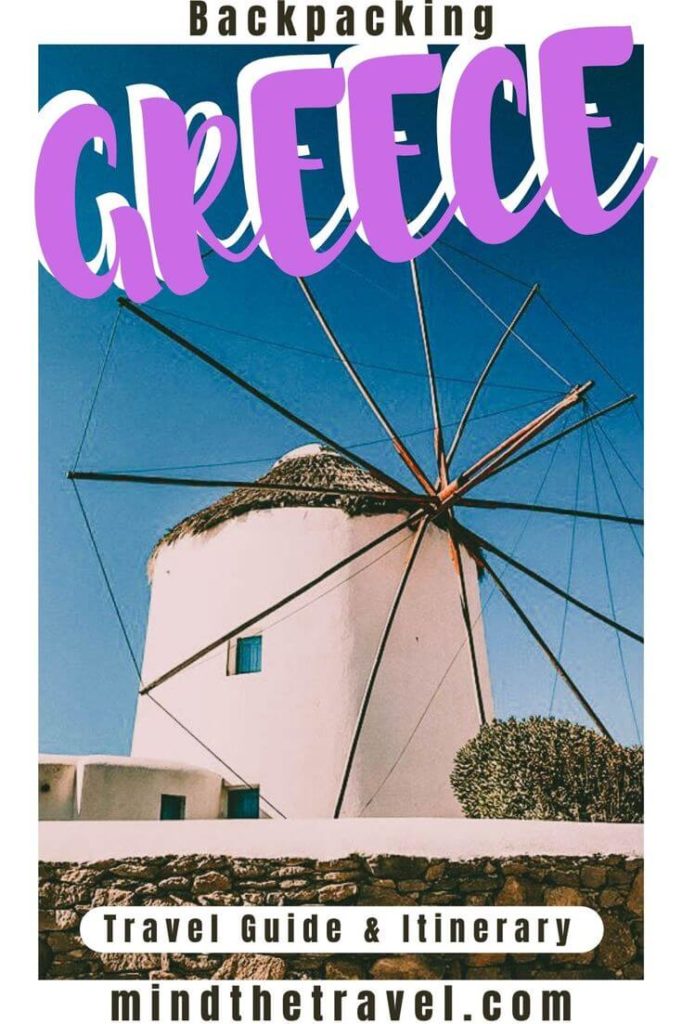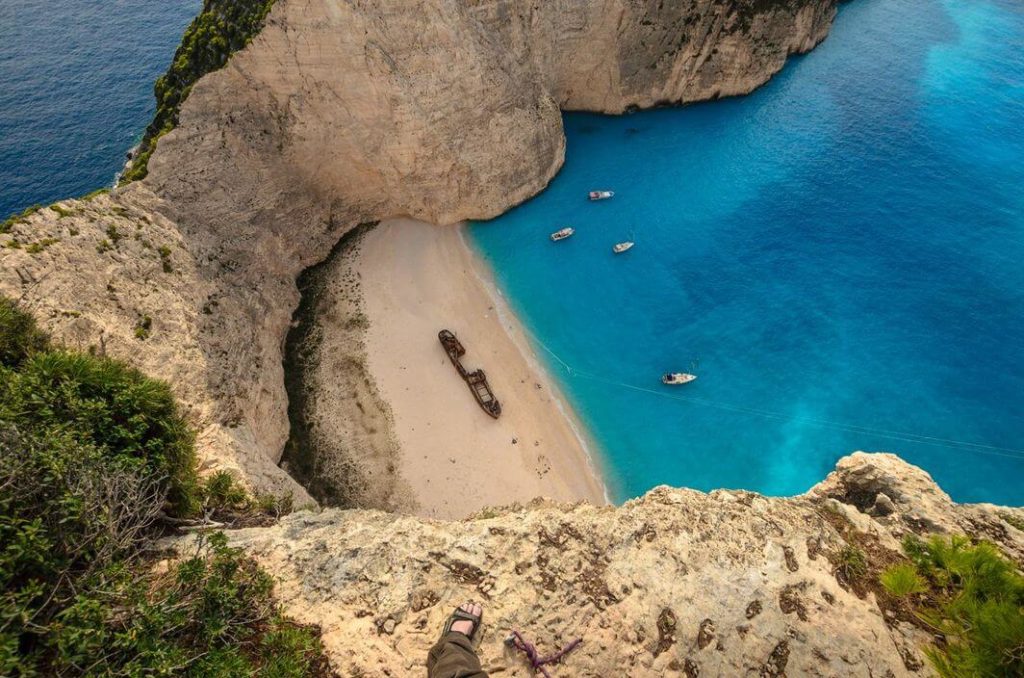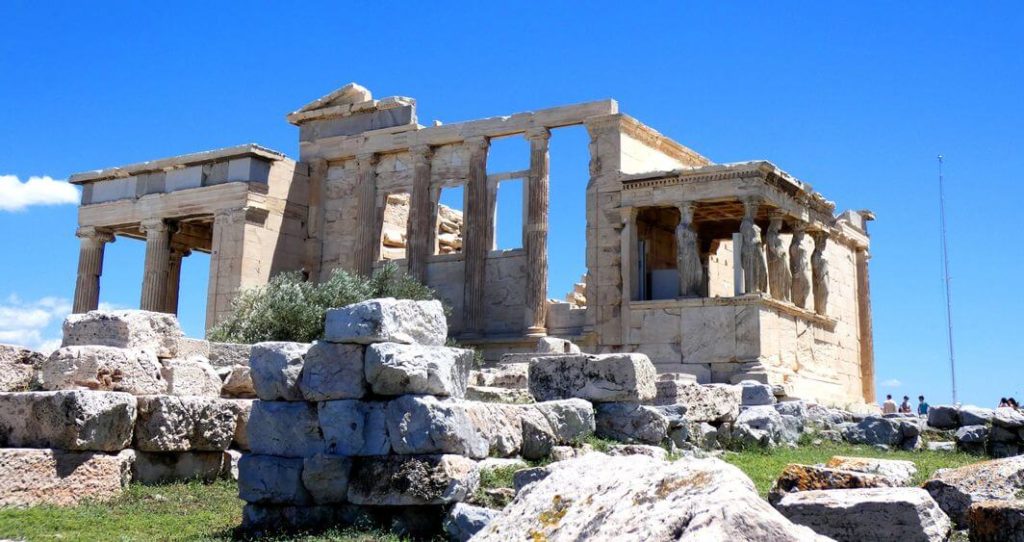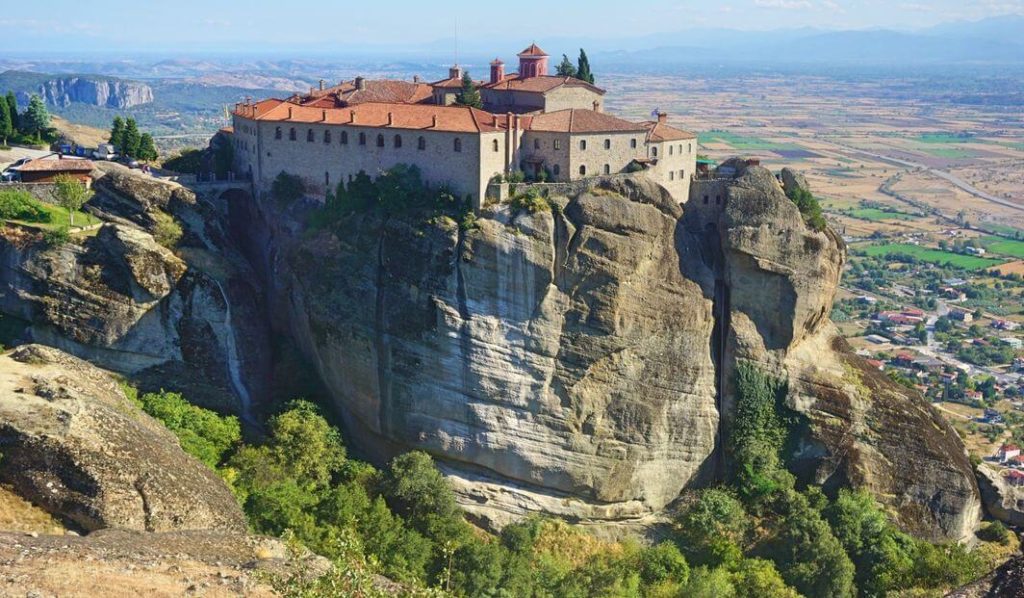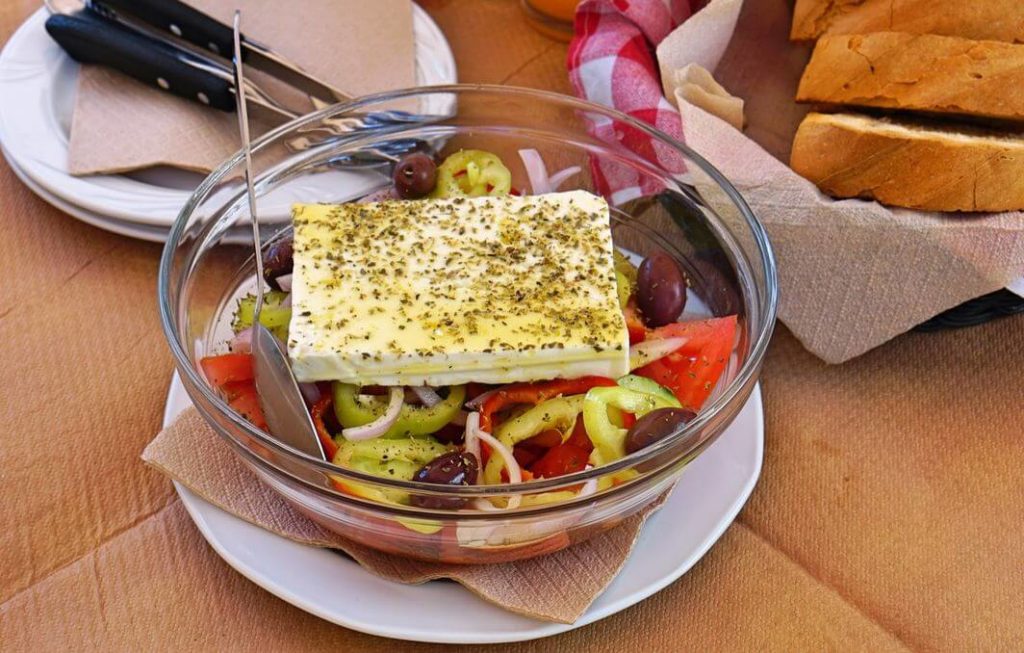Best Travel Itineraries for Backpacking Greece
Combine the itineraries below to create a larger backpacking route. Or simply use any of them as they are to make your backpacking experience in Greece even more fun!
Greek Islands Itinerary 10 Days: Ionian Islands
Patras (Day 1)
Hop on a plane in Athens to take a 50-minute flight to Patras. Capital of the Achaia prefecture, Patras is a major seaport and a nice jumping-off point for the Ionian Islands. Get there as early as you can to get the most out of your visit. If you only do one thing, visit Archaeological Museum with its enormous metallic dome.
Ithaca, Greece (Day 2-3)
While Ithaca doesn’t seem to be on most tourists’ itineraries in Greece, this Ionian Island attracts everyone who just wants a laid-back holiday in beautiful surroundings. According to Homer, Ithaca was the home of Odysseus and the legend has it the Palace of Odysseus used to be in the area between Exogi and Platrithias, which is now an archaeological site. Spend some time here exploring the ruins, check out Vathi and Kioni before heading to a beach.
Kefalonia (Day 4-6)
I suggest you stay for 3 awesome days in Kefalonia, the largest of the Greek islands in the Ionian island chain. Kefalonia is a lush green island with hidden beaches and caves. It was occupied by the Venetians, and reunited with Greece after a period of British rule. The island offers a bit of everything – authentic culture, historic sites, incredible beaches, and friendly people. Kefalonia is a great place, which is why it’s worth spending a full week there. Myrtos Beach and Melissani Lake are my favorite places to visit in Kefalonia.

Zakynthos (Day 7-9)
Blessed with scenic landscapes, incredibly rich underwater world and fantastic local cuisine, Zakynthos is a must for those who like to snorkel in turquoise and crystal clear waters. Along with Santorini, Navagio Beach is Greece’s most recognizable spot because of its beauty and the remains of a ship laying down on the beach. Visit museums such as the Byzantine, and the historically important Roma Mansion or take a day trip to the Blue Caves or the tiny mountainous village of Volimes. Head back to Athens on day 10.
Back To Athens (Day 10)
Hop on a ferry over to Kyllini in the Peloponnese. If you have some extra time, visit Sparta or ancient Olympia. Then, it’s the long drive back to Athens.
Greek Itinerary 14 Days: Athens, Mainland Greece, Cyclades and Crete
This is the perfect itinerary if you want to soak up quintessential Greece views, as well as experience the beauty and culture. If you have more time, you can combine this itinerary with the one above, but it may involve a bit more planning.
Backpacking Athens (Day 1)
Start your backpacking adventure in Athens, home to the iconic Acropolis, Plaka Neighbourhood and Lycabettus Hill. The city offers plenty of things to do. Every neighborhood here takes you through a journey back in time as you walk the same streets Sophocles used to walk in and be in the same places Socrates used to teach.
Visit Acropolis (Day 2)
Spend your entire day exploring the mighty ruins of the Acropolis and the area around it. This fascinating 5th-century BCE complex can be seen from pretty much anywhere in Athens. Visit the city’s main religious center with a guided tour. Otherwise, check out the Temple of Athena Nike, the Erechtheion, the Temple of Hephaistos, and the highlight of any trip – the Parthenon, on your own. Oh, and don’t miss out on visiting Anafiotika neighborhood – it’s charming!
Day Trip to Delphi (Day 3)
On your third day in Greece take a day trip to Delphi. The city is a must-see for history, archaeology and Greek Mythology buffs! Once known as the navel of the world and home to the Oracle, Delphi boasts some impressive attractions like the Delphi Theatre, the Temple of Apollo, The Delphi Museum and The Temple of Athena Pronaia. You can visit Delphi with a guided tour or by bus. Buses from Athens to Delphi make the trip in about 3 hours thus go with the earliest bus.
Athens to Mykonos (Day 4)
When it comes to island-hopping in Greece, the idyllic city of Mykonos is one of the top places to visit. Known for its whitewashed and blue-roofed houses and traditional windmills of Chora, Mykonos is arguably the most popular Greek island. It is a mecca for solo travelers, party animals, couples, windsurfers, and families with many things to do. I have been to the island twice and each time I had a blast!
Day Trip to Delos (Day 5)
Delos Island is even smaller than Mykonos but is’s said to be one of ancient Greece’s most sacred sites. Delos was the center of the Cyclades during the Classical era and the mythological birthplace of Apollo and Artemis. Once you’re there, head over to the House of Cleopatra, see the Agora of the Italians and explore the Lions’ Terrace. You can arrange a tour through any hotel or get your ticket from a booth at the Old Harbour.
Backpacking Santorini (Day 6)
Catch an early ferry over to Santorini. With its dramatic cliff views, its whitewashed villages and beautiful beaches of black sand, Santorini is the most instagrammable place in Greece. This volcanic island boasts 12 scenic walking routes. Walks range in distance from two to eight miles each. In the evening, enjoy baked Santorini white eggplant with feta and bread crumb at one of the local restaurants. Keep in mind, the town Kamari offers mouthwatering seafood at very affordable prices, lower than anywhere else on the island!
Explore Akrotiri. Take a Ferry to Crete (Day 7)
Take a guided tour to the ancient site of Akrotiri. This is one of the most important prehistoric settlements in the Aegean Sea and definitely one of the island’s best places to visit. An ancient Minoan city of Akrotiri is often compared to Pompeii, in Italy. It was buried by a volcanic eruption in 1,613 B.C. but rediscovered in 1967. While the excavations are still ongoing here, you can admire the ancient buildings, the streets and many ceramics. Once you’ve soaked up enough history, hop on a ferry to Crete.
Backpacking around Heraklion, Knossos, and Chania (Day 8)
The 3,500-year-old Knossos Palace with a sprawling maze of royal chambers, storerooms, workshops and its upside-down columns was the center of Minoan civilization. Even though the palace was badly damaged by fire and earthquake during the ancient times it retains images on the walls that provide insight into Cretan life in the late Bronze Age. The myth of Theseus and the Minotaur revolves around the Knossos Palace, which is only a stone’s throw away from Heraklion.
The city of Heraklion is home to some impressive Venetian architecture, a maze of crooked, narrow streets and amazing Archaeological Museum. In the evening, head over to Chania, a city on the northwest coast of Crete influenced by past Ottoman and Egyptian cultures.
Hike the Samaria Gorge (Day 9)
Spend this incredible day hiking through Samaria Gorge. This is my favorite trek in Crete as it passes through a tranquil forest, and the scenery is so stunning. To make things much easier, consider joining a tour group. Otherwise, you can hop on a bus from Chania to the Xyloskalo trailhead. You have to be physically fit to hike Samaria Gorge because it usually takes up to hike the 16 kilometers from the Xyloskalo trailhead to Agia Roumeli. If hiking isn’t your cup of tea, you may want to explore the ruins of ancient Aptera in Chania.

Head Back to Athens (Day 10)
Hop on an early ferry to Athens to continue your explorations on the mainland. Then take a 30-minute bus ride to Eleusis and its vast archaeological site. These ruins were the site of one the most enthralling rituals of ancient Athens. The huge annual festival attracted thousands of pilgrims seeking initiation into the cult of Demeter. The ritual is so intriguing yet often unknown that it’s still referred to as the Eleusinian Mysteries. Spend the day in Eleusis and see what you can find out.
Backpacking Mycenae and Nafplio (Day 11)
Depart from Athens in the morning to reach the Corinth Canal in about one hour. Then head over to the archaeological site of Mycenae. Once a mighty citadel and the most powerful town of the Mycenaean civilization, now home to the Lion Gate, the Treasury of Atreus and the Cyclopean walls, whose construction method is still a mystery.
Once you quenched your thirst for history set off to the picturesque town of Nafplio, the first capital of Greece. Spend the rest of the day exploring narrow streets, elegant Venetian houses and neoclassical mansions. I recommend climbing up 900 plus steps to the top of Palamidi fortress for stunning views.
Day Trip to Olympia from Nafplio (Day 12)
Situated on the western side of the Peloponnese, Olympia is an iconic place to visit in Greece. This ancient town is known to be the birthplace of the Ancient Olympic Games. While the Lightning Ceremony of the Olympic flame still takes place in Olympia before every opening of the Modern Olympic Games, there’s a lot to cover aside from it. Here you’ll find the ruins of Zeus Sanctuary, as well as the ancient stadium and the Archaeological Museum. If you have enough time check out the castle of Acronafplia once you return to Nafplio later in the day.
Return to Athens (Day 13)
On your last day in Greece, you can either explore the Athenian Riviera or see some other attractions in Athens. Watch the Changing of the Guard at Syntagma Square that takes place in front of the Tomb of the Unknown Soldier monument at 11 am daily. Wander around the Agora, take a seat at the theatre of Dionysus or climb to the Philopappos Monument. In the evening hop on a bus to enjoy a sunset at Cape Sounion. Alternatively, head over to the Mnisikleous Street stairs. A great place to socialize, mingle with locals and feel the vibes of the city.


